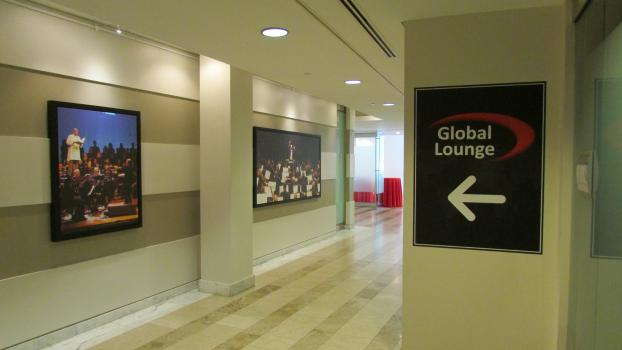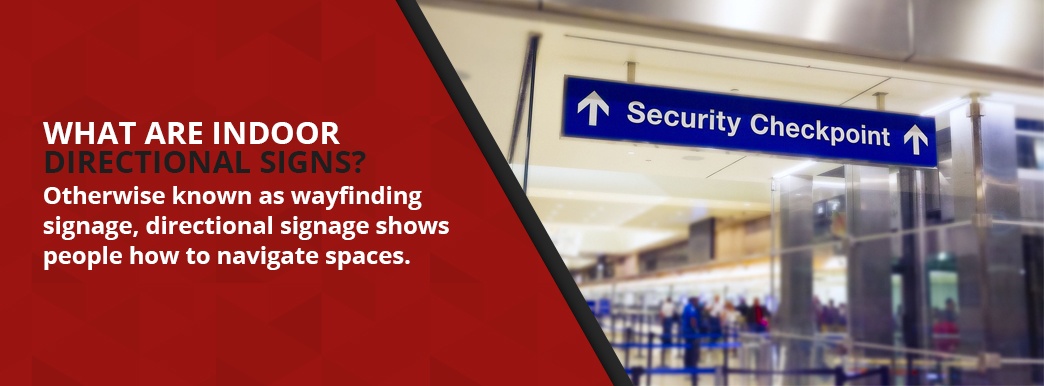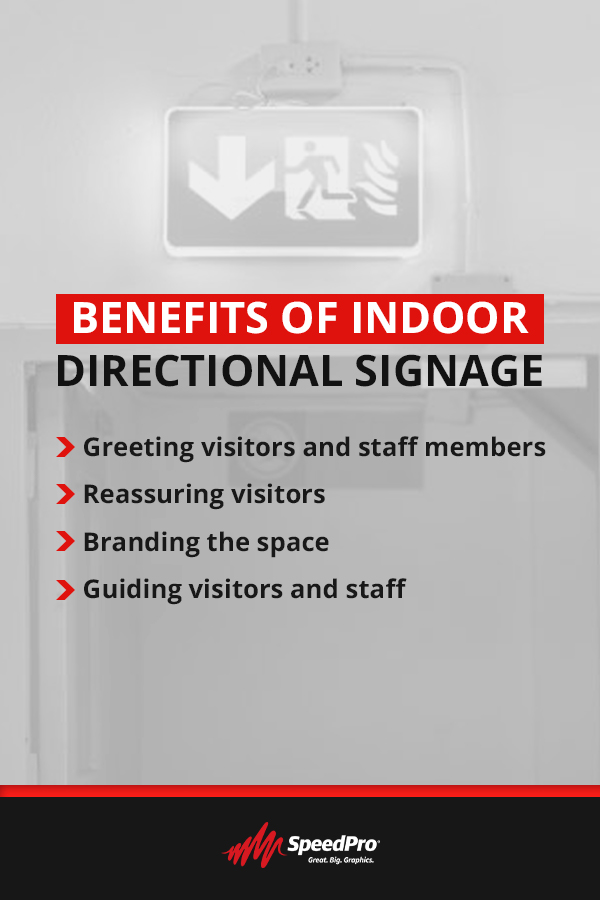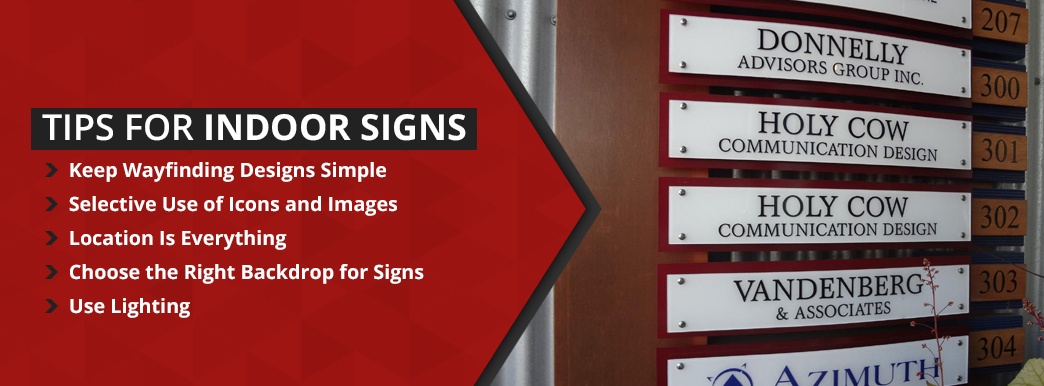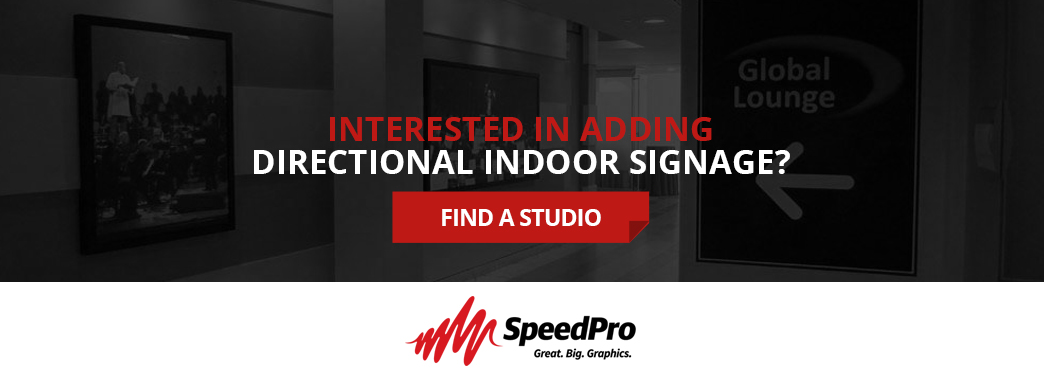Your outdoor signage can draw customers or clients in, but once they are inside, they need to be able to know where they need to go. Indoor directional signage will capitalize on people visiting your facility, showing them where to go and aiding their experience with your organization.
Harnessing the benefits of indoor wayfinding signage is important for any company, but especially for those with a large facility. Consider how these signs can improve the interior of your space and see if they are right for you.
What Are Indoor Directional Signs?
Otherwise known as wayfinding signage, directional signage shows people how to navigate spaces. Since directional signs have a great deal of functional value, a variety of organizations use them, and you probably encounter many of them as you go about your day-to-day life.
Organizations generally use custom directional signs for a few main applications:
- Give directions: Like the name might suggest, indoor directional signs, in their basic form, will give people directions around a building. Generally, these types of signs will use large arrows and attention-getting messages to show visitors and staff members where they need to go.
- Naming rooms: These kinds of signs will be useful to designate the names and numbers of offices, event halls, meeting spaces and conference rooms. Wayfinding signage is especially useful for newcomers who may not be able to find key locations around a building. Instead of having to ask where someone’s office is, they can read a sign and find it. Having a name in front of an office door has an added benefit of being a status symbol that some employees will find attractive.
- Showing an area is restricted or special: Often, event spaces will have restricted areas where only staff members or VIP attendees are allowed. To make sure that people are only accessing areas that are meant for them, you’ll want to include directional signage. Along with event spaces, the same principle can apply to office directional signs. For example, if you need to section off certain areas for staff, directional signs can help.
- Providing information: One of the best things a wayfinding sign can do is include relevant information that visitors will need. For example, an informational directional sign can provide a list of the offices in the building, with the numbers and employees who occupy them listed.
- Federal and state regulation compliance: Due to the Americans with Disabilities Act, organizations are required to install a variety of informational and wayfinding signage around their property. These signs have to be accessible for visual and tactile readers. Typically, these signs will be needed around handicap-accessible bathrooms, elevators and other areas.
Benefits of Indoor Directional Signage
As you consider whether indoor signage is right for you, you’ll need to be aware of the benefits that indoor signage can provide for an organization. The following are some of the greatest benefits that indoor signage can give your organization:
- Greeting visitors and staff members: When visitors or new staff members walk into a location, you’ll want them to feel welcomed into it. By showing people where they should go and making a point to give them as much information as possible, you’ll show them that you care about their wellbeing. This sort of welcoming atmosphere is incredibly important for companies that consistently host events or have a stream of clients and vendors visiting their office space.
- Reassuring visitors: If you have a large facility that visitors consistently have to navigate, you’ll want to let those unfamiliar with the space know that they are headed in the right direction. Having wayfaring signage placed consistently around the facility will let visitors know they are on the right path. At all times, a visitor should be able to quickly find out where they are and how they can get to where they need to go.
- Branding the space: When people walk into your buildings, you want to provide them with a consistent image of your company. Directional signage that uses branded imagery, colors and fonts will add to the visual appeal of the space. For example, directional signs for events will both show potential customers or clients around the event space and turn the event into a branded experience, where the company’s image is consistently reinforced.
- Guiding visitors and staff: The most obvious benefit to companies is the ability of signage to guide people around the facility. Instead of people wasting time trying to find out where to go or having to ask busy staff members for directions, they’ll be able to independently navigate a facility quickly. With easy to understand directional signage, you’ll save visitors’ time and also the time of employees as they will not have to explain how to navigate the facility.
Where to Place Indoor Directional Signs
To aid in the functionality of directional signs, the best companies know where to place the signs so that they are the most visible and helpful to those passing by. There are a few common locations that are great for signage:
- Entrances and exits: People need to know where the entrance and exit to your facilities are. Directional signs for events are even more crucial as the attendees and staff will likely be even less aware of the event space. Ensuring that they always know how to enter and exit the event will be important.
- Accessibility points: Those with different accessibility needs need to be able to find services and part of the building that caters to their needs. For example, if someone is in a wheelchair, there should be directional signs that indicate where they can find the elevator and then have signs clearly mark wheelchair-accessible restrooms. Office directional signs will need to be designed to assist employees and clients with different accessibility needs.
- Departments: If your facility has several departments, you can use wayfinding signs to show where departments are located. For example, the signs can be placed outside of floors or hallways where a particular department operates to identify it. This sort of signage is perfect for organizing a building.
- Office, hall or room space: Similar to department wayfinding signage, signs that are placed outside of offices, halls or rooms can give extra information about the location. Typically, these signs will be placed directly on doors or to the side of them. One example would be the name and position of someone on a small sign or plaque beside their office door.
- Restrooms: Signs for restrooms are crucial for a visitor’s positive experience while they navigate the building. Visitors need to know where restrooms are quickly and know which ones are appropriate to use. Signs will often be placed to the side of restrooms to identify them or in visible areas that direct users to the restroom.
In addition to the above locations, many other business and industry-specific locations require signage, such as cafeterias and lounge spaces. Depending on your organization’s needs, you may want to place signs in other key locations. If people need to access a location, it’s likely that you should use a wayfinding sign to point people towards it.
Directional Floor Decals
Along with typical signs that are placed on the sides of walls or hung from the ceiling, you can also place directional signage on the floor of your facility. A directional floor decal can be a creative and stylish way to show where people should be going.
A floor decal can mark a path that consumers are meant to follow, label areas to maintain crowd control and add a visual flair to your facility. A creative directional floor decal may come in the form of decal footprints that have customers follow them to the location they need to find. A more conservative floor decal may simply be installed on the floor and point a viewer in the direction of a location that you want them to find.
If you’re looking to add some extra flair to your space, provide practice value and further brand your facility, directional floor decals are perfect.
Tips for Indoor Signs
If you want to get the most out of your directional signs, follow some guidelines. Whether you need directional signs for businesses or for events, it’s important to implement them properly.
Below are some of the most important tips that you should follow while you design and install custom directional signs:
1. Keep Wayfinding Designs Simple
Though some companies are often tempted to craft signs with complex designs, they often forget the most important a part of directional signs — the directions need to be as clear as possible. Keeping the design simple allows readers to see where they need to go quickly.
The ideal wayfinding sign will be to the point and easy to understand. One way to make this possible is by using shades and colors that line up with your brand’s color schemes. The colors will already be familiar to readers and help them get to the message faster. In addition to familiar color schemes, the font should be simple, in a size that can be read from close by or far away.
If you include graphics with the directional sign, keep the pictures and symbols subtle so as not to overshadow the sign’s message. The general principle you should follow with designing signage is to be attention-getting without distracting from the core message.
2. Selective Use of Icons and Images
Along with text, it’s best practice to include images on directional signage. Though you’ll need to use images, you’ll want to use them wisely. Instead of complex shapes or images, it’s important to use simple outlines and shapes that people are familiar with. For example, an image of a wheelchair sign is universally recognized in the United States as a symbol for disability access. Even without language, people should be able to get an idea of what a sign is trying to communicate.
Along with simple shapes, some signs can use more detailed pictures and images. For instance, you may want to brand some of your signs to fit into your company’s larger aesthetic. On these signs, you can include your company’s logo or other iconic imagery that doesn’t distract from the primary message. In addition, a branded directing sign is perfect for trade shows, where a company needs to distance themselves from the competition and get attendees to notice their booth.
3. Location Is Everything
The first step to employing effective signage is to make sure that people can actually see the sign. Place wayfinding signs in locations that are highly visible and are not obstructed. The ideal location will be in a place that visitors, especially those who are unfamiliar with a building, can quickly find, and then be able to read easily to identify where they are or need to go.
4. Choose the Right Backdrop for Signs
When you set up a sign, you need to make sure that the backdrop complements it. Even if a sign is perfectly designed, it needs to work with the backdrop to get its message across clearly. If the signage clashes or is overshadowed by the backdrop, people may not notice the signs or might even form a negative impression of your company.
Before you design a sign, consider if the backdrop is going to be made of wallpaper, paint, glass, brick or siding. After you determine the material, you’ll want to know the color scheme of it to make sure that the signage matches it.
A backdrop should not distract from the sign and be as visually clean as possible. Rather than distracting from the sign, the backdrop should act as a sort of blank template that the sign can be combined with to provide directions and other relevant information to visitors. A clear, simple backdrop will usually be the best option for complementing the message of the sign.
5. Use Lighting
Along with designing an attractive sign, placing it in the right location and finding a proper backdrop, you will want to use lighting to highlight your sign’s message and design. It’s best practice to install signs near a direct lighting source, as this kind of lighting will illuminate glass, plastic and vinyl substrates. LED wall lights, wall sconces and picture lights are often great options to pair with a sign as they will not cause glare, have uniform light distribution and enhance the sign’s readability.
Interested in Adding Directional Indoor Signage?
If you want visitors and employees to have the best experience possible while navigating your facilities, you’ll need to use indoor directional signage throughout your facility. SpeedPro can help you create indoor directional signage that will add both functional and visual appeal to your facilities.
As a large nationwide network that specializes in large-format graphics, SpeedPro has the experience and capability to turn your designs into stunning wayfinding signage. Find your local studio to speak to one of our local representatives about your indoor directional signage options.

















